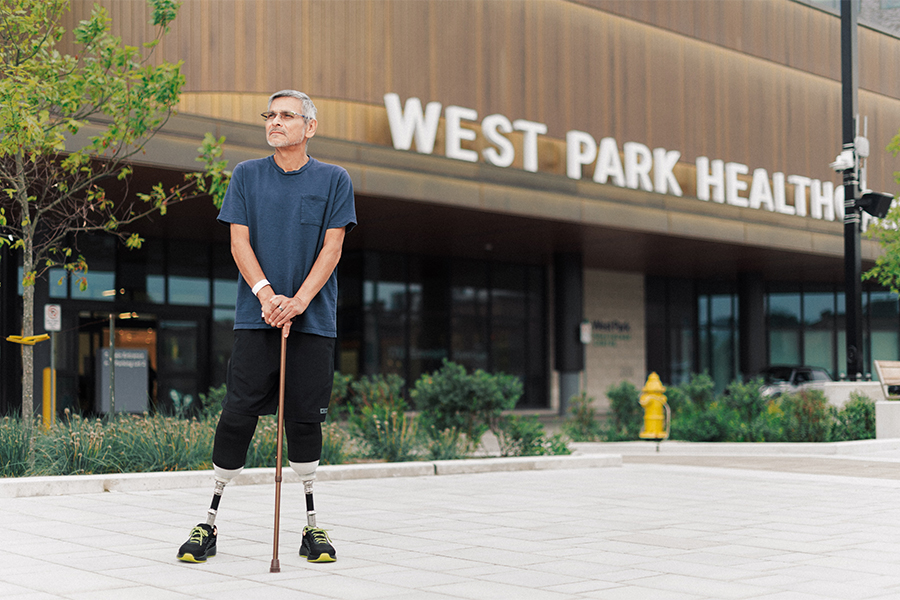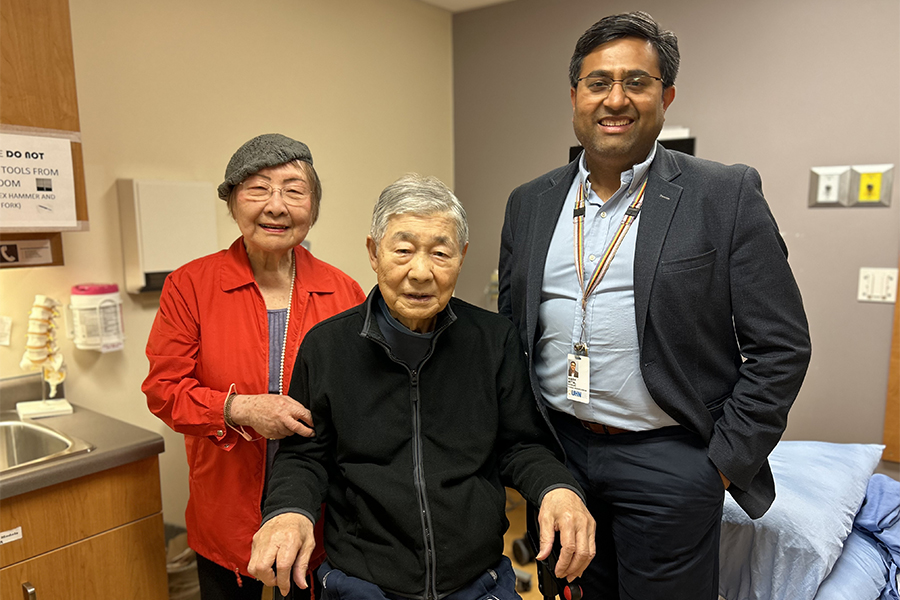Posters are one way to introduce the topic of sex and intimacy, and send the message to patients that “it’s okay to talk about this.” Pictured here: Intimacy After Stroke Working Group Co-Leads, Vanessa Ong (L), and Nina Hovanec. (Photo: UHN)
“It’s a very important part of life. A lot of us have questions about it, but won’t actually ask on our own.”
This is what one Toronto Rehab patient told her physiotherapist, Taylor Prentice, when the topic of sex after stroke was introduced as part of her recovery.
Sex and intimacy – a commonly overlooked theme in rehabilitation – has recently found its rightful place within the forefront of patient care. And it’s thanks to a committed team of colleagues in Toronto Rehab’s Stroke Rehab Program, who recognized a service gap, and took the steps to fill it.
“We identified an opportunity to enhance patient care – not only by developing original resources that help answer questions and overcome physical challenges, but by establishing various entry points to access the information,” says physiotherapist Nina Hovanec, who, along with physiotherapy colleague Vanessa Ong, co-led the Intimacy After Stroke Working Group.
“We’ve normalized the conversation.”
Making everyone feel invited to the conversation
While we may not immediately associate sex and intimacy with rehabilitation, it’s part of many patients’ overall well-being, and, in turn, an important theme for clinicians to be able to address.
“If your goal is to relearn how to eat independently, or walk up the stairs, we’ve always been able to help you work toward that,” says Nina. “Now, if a patient wants to learn how to be intimate with their partner again, we can help with that, too.”
The initiative originally started off small, with the intention of collecting sexual health material that was relevant to a post-stroke population, and already existed in the community. But when their search came up with little, the team realized if they wanted to provide this information to patients, they’d need to create it themselves.
“That started us on the path of developing our own resources reflecting the people we care for,” Vanessa says. “We wanted them to be inclusive and diverse, so everyone feels invited to the conversation.”
It was a collaborative effort among an interprofessional team. It included nursing, pharmacy, medical, Allied Health; as well as a patient advisory group, Patient Education, Visual Services, the UHN Public Website Team, and even Nina’s sister, who volunteered her time to design some initial concepts.
The working group developed a list of resources on UHN.ca, so they’re accessible to everyone.
For patients, resources touch on frequently asked questions; commonly prescribed medications that may impact intimacy; and aphasia-friendly visual guides to safe sexual positions.
“Patients are often unsure about how to protect parts of their bodies that are weaker, or experiencing paralysis,” says Taylor. “They find the safe positioning materials to be especially useful.”
The team has also created posters, which they call passive influencers.
“I love how the poster images are intentionally neutral, inviting anyone who sees them to project themselves onto the image, regardless of your age, gender, or ethnicity,” says Nina.
For clinicians, sex and intimacy has been added to the program’s standard goal-setting forms, and new resources include a script to help get the conversation started, and a referral checklist, adapted from Toronto Rehab’s Spinal Cord Injury Rehab program. The checklist breaks sex and intimacy down into smaller topics, from sensory changes to self-esteem, and identifies the most appropriate profession to refer to, for support.
Taylor says she likes the checklist because of the breadth of themes it covers.
“It also ensure a patient’s needs are being met by the most appropriate multidisciplinary team member, instead of one individual trying to address all the questions, themselves,” she says.
“To me, that’s client-centered care.”
Impacting recovery beyond our walls
Now that the working group is established, the team is confident that they’re well positioned to continue formulating new resources, as gaps continue to be identified.
“We see it as an ongoing quality improvement project,” says Vanessa.
In the meantime, they’re gaining recognition among peers and have recently been honoured with Toronto Stroke Networks’ 2021 Standards of Care Quality Improvement People’s Choice Award.
Their work is also gaining momentum in the community. Since going live on UHN.ca, resources have been viewed about 1,300 times.
“We have a lot of healthcare partners reaching out to us, asking if they can repurpose the materials, and we always say, ‘yes!'” says Vanessa. “That’s why we created them – to break down barriers and provide people with a springboard.
“When we were out there, searching for this material, we couldn’t find it. Now that others are in the same boat, we’ve made it easier for them to access what they need.”


